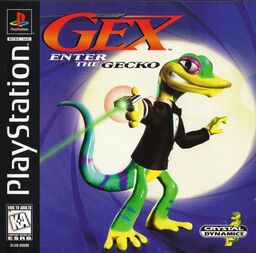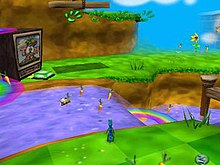software.wikisort.org - Video_game
Gex: Enter the Gecko[lower-alpha 2] is a 1998 platform game and the second installment of the Gex video game series, released in 1998 and 1999 for the PlayStation, Nintendo 64, Microsoft Windows, and Game Boy Color. Its protagonist, Gex, a TV-binging, wisecracking gecko, is voiced by Dana Gould in the North American version, Leslie Phillips in the European release, and Mitsuo Senda in the Japanese release. Gex seeks to collect three types of remotes to unlock different TVs in the overworld that aid in the fight against his arch-nemesis, Rez.
| Gex: Enter the Gecko | |
|---|---|
 | |
| Developer(s) | Crystal Dynamics[lower-alpha 1] |
| Publisher(s) |
|
| Director(s) | Glen Schofield |
| Producer(s) | Jeffrey Zwelling |
| Designer(s) | Evan Wells |
| Programmer(s) |
|
| Artist(s) |
|
| Writer(s) |
|
| Composer(s) |
|
| Series | Gex |
| Platform(s) | PlayStation, Nintendo 64, Microsoft Windows, Game Boy Color |
| Release |
|
| Genre(s) | Platform |
| Mode(s) | Single-player |
After creating the original Gex, which released for the 3DO Interactive Multiplayer, PC, Sega Saturn, and PlayStation in 1995, developer Crystal Dynamics sought a sequel in the form of a 3D platform video game in the style of Super Mario 64. The Gex model was rebuilt with this perspective in mind, and much of the game's humor was inspired by Fox's animated television series The Simpsons, on which script writer Rob Cohen had previously worked as a writer. Hundreds of voice-overs were recorded for the character Gex, but hardware constraints forced the Nintendo 64 version of the game to include only around one hundred samples. The Nintendo 64 release, due to hardware limitations, features six fewer levels than its PlayStation counterpart, but the release also includes one exclusive level, "Gecques Cousteau".
Critical reception of Gex: Enter the Gecko was mostly positive. Critics' main concerns centered on the game's camera, graphics, low-polygon enemies, and simplicity. The game was followed by 1999's Gex 3: Deep Cover Gecko, which released on the PlayStation, Nintendo 64, and Game Boy Color.
Gameplay

Enter the Gecko, the first 3D platform game in the Gex franchise, allows the player to choose from three camera control options: automatic, semi-automatic, and manual. The player controls Gex (voiced by comedian Dana Gould in the North American release, Leslie Phillips in the European release, and Mitsuo Senda in the Japanese release), who has spent much of his time watching television. His dialogue consists of references to popular culture from the late 1980s and 1990s, usually spoken when he enters a level, attacks, dies, or collects items. Dialogue and scenes were heavily cut for the Nintendo 64 version due to hardware limitations.
Gex's move set includes a tail whip attack, a tail bounce, and a flying karate kick. His ability to climb certain walls and ceilings is a quality borrowed from the real-life gecko on which Gex is based. Gex may use his tail whip around levels to break small TV sets that contain different colored flies, which, when consumed, can add an extra health point, add an extra life, temporarily unlock additional moves, or mark a checkpoint in the level if the player runs out of health.[1] Specific stages can require Gex to collect power-ups to move throughout the level or to just stay alive, as is the case with the outer space stages in which Gex must collect oxygen for his astronaut suit. While the majority of enemies can be defeated using Gex's move set, others can only be eliminated when Gex manipulates objects or machinery around him. For example, a dragon in a Kung Fu level early in the game can only be slain after Gex targets it with a cannon.
TV sets in the game's hub world act as entry points to different stages, which parody popular culture, such as Looney Tunes and Star Wars. Excluding bonus stages, each level has a set number of red remotes for Gex to collect along with silver remotes, which are awarded for collecting 120 collectibles or discovering a hidden secret. Red remotes can be collected after standing on the green button in front of in-world television screens after completing level-specific objectives, which can be completed in any order regardless of which one is chosen on the level screen. Collecting red remotes unlocks new areas in the hub world along with bonus and boss levels, which reward a gold remote upon completion. Collecting all remotes in every stage unlocks a special ending showcasing the game's concept art.
Nintendo 64 version
The Nintendo 64 version features "Gecques Cousteau", a new level centered on the RMS Titanic and played almost entirely underwater. Due to the console's cartridge storage limitations, six levels were removed, which include three secret levels ("Lava Daba Doo", "Texas Chainsaw Manicure", and "Mazed and Confused"), one normal level ("Poltergex"), and two bonus levels ("I Got the Reruns" and "Trouble in Uranus"). Other changes include fewer bonus levels, fewer quotes, and altered sound effects.
Plot
Following his victory over Rez in the Media Dimension, Gex has retired from the public eye and turned to solitude.
Two years later, his quiet life is soon turned upside down when one day he was watching television when all of a sudden, it goes blank and Rez's image begins flashing on the screen. Two government agents also appear and abduct Gex to their headquarters, in which Gex is interrogated. The agents explain that Rez has returned and they need his help in taking him down again. Gex refuses, saying that he has already saved the world once and that they should try to find someone else. When the agents make a fair negotiation for a huge sum of cash and gadgets, Gex tells them everything. He accepts the mission, to which he leaves the building and is then accosted by a female agent who introduces herself as Agent Xtra and wishes him good luck.
After navigating numerous television channels in the Media Dimension, Gex finally confronts Rez and the two battle once again until Gex drops a huge television set on Rez severely weakening him. In desperation, Rez tells Gex through a television that he is his father. Gex merely turns the television off. Whether or not he believes Rez is unknown. In the final scene, Gex shares a hotel room with Nikki from the Pandemonium series.
Development

Following the modest success of 1995's Gex on the 3DO Interactive Multiplayer, Sega Saturn, and PlayStation, a sequel was soon in development. In early 1997, Crystal Dynamics announced that they were working on a 3D sequel to Gex in the style of Super Mario 64.[2] Crystal Dynamics originally wanted to relaunch the character with the technology available at the time. Rather than a grouping of polygons, Gex was built with a full skeletal system, with more bones than a real gecko, and a 'skin' stretched over-top to eliminate pop and tearing. This also allowed him to move his mouth along with the voiced dialogue.[3]
The Simpsons, a series the developers were fond of, made for a noteworthy inspiration for the comedy set-ups based upon the show's style of humor. Rob Cohen, a writer from The Simpsons, worked on the script for Gex: Enter the Gecko, particularly Gex's one-liners.[4] The end result of the idea gave Dana Gould over 700 voice-overs for Gex, while giving the character different costumes in order to suit the mood of the levels. When the game was released for the Nintendo 64, over 500 voice-overs from the PC and PlayStation versions were cut out from the original version, giving the Nintendo 64 version roughly over 100 samples to work with for the purpose of the hardware's limitations at the time of development. When Gould was being interviewed for the game, he explained how Gex in the third dimension differed from other platform games at the time. Gould said "the character's natural God-given abilities lend themselves extremely well to designing 3D gameplay".[5] Gould reprised the role of Gex in the game for the American market, although the British version featured the voice of Leslie Phillips instead.[6]
The designers put heavy emphasis on variety in the levels, in order to both give each world a different feel and help the player find their way around by creating recognizably unique landmarks.[7]
In mid-1997 Crystal Dynamics signed an agreement for Midway Games to publish the game for the PlayStation and Nintendo 64.[8]
Reception
| Aggregator | Score |
|---|---|
| GameRankings | PS: 82%[9] N64: 61%[10] |
| Publication | Score |
|---|---|
| Next Generation | |
| Game.EXE | 70%[12] |
| Game World Navigator | 6.6/10 |
| Strana Igr | 7/10[14] |
Gex: Enter the Gecko received mostly positive reviews. Aggregating review website GameRankings gave the PlayStation version 82%.[9] The Nintendo 64 version received mostly mixed reviews. GameRankings gave the game 61%.[10] Upon the PC version's initial release, USA Today gave the game "4 out of 5 stars!" GamePro acclaimed the game to be "A must-own for platform fans!"[15] Game.EXE reviewer gave the game a 70% score and said that it lacked attention to detail and care.[12] A Game World Navigator reviewer praised the graphics, noting that the backgrounds are detailed, but noticed that the monsters have few polygons. The reviewer complained about the bad behavior of the camera, and eventually concluded that the game is worth playing. Dmitriy Estrin, reviewer of a Strana Igr magazine, commented on the graphics, saying that the "developers skillfully managed the resources available to them", but he also noticed that the game had "too much simplicity in all aspects of the gameplay".[14]
Next Generation reviewed the PlayStation version of the game, rating it three stars out of five, and stated that "Crystal Dynamics has taken a bold, innovative step into the 3D platform genre with Enter the Gecko by providing humor, solid design, and clever enemies, but the gameplay still needs a little time to catch up".[11]
Notes
- Ported to Nintendo 64 by Realtime Associates, David A. Palmer Productions for Game Boy Color and LTI Gray Matter for Windows.
- Also known as Gex 3D: Enter the Gecko or Return of the Gecko; or as Gex 64: Enter the Gecko on the Nintendo 64.
References
- "Gex: Enter the Gecko" (PDF). Electronic Gaming Monthly. No. 99. Ziff Davis. October 1997. p. 185. Archived (PDF) from the original on 2020-07-19. Retrieved 2020-07-19.
- "In the Studio". Next Generation. No. 28. Imagine Media. April 1997. p. 19.
- EPNdotTV (2016-01-25), Electric Playground: Season 1, Episode 5, archived from the original on 2019-08-07, retrieved 2018-08-22
- "E3 Unleashed!". GamePro. No. 106. IDG. July 1997. p. 40.
- Gex 64 The Official Strategy Guide, 1998 Millennium Publications Inc., (p. 111-112)
- "Gex: Enter the Gecko Credits". Allgame. Archived from the original on November 15, 2014.
- "NG Alphas: Gex: Enter the Gecko". Next Generation. No. 31. Imagine Media. July 1997. pp. 114–5.
- "Tidbits..." (PDF). Electronic Gaming Monthly. No. 99. Ziff Davis. October 1997. p. 22. Archived (PDF) from the original on 2020-07-19. Retrieved 2020-07-19.
- "Gex: Enter the Gecko for PlayStation". GameRankings. Archived from the original on 2011-09-10. Retrieved 2011-10-24.
- "Gex 64: Enter the Gecko for Nintendo 64". GameRankings. Archived from the original on 2011-07-11. Retrieved 2011-10-24.
- "Finals". Next Generation. No. 42. Imagine Media. June 1998. pp. 135–136.
- Господин ПэЖэ (July 1998). "Gex 3D: Enter the Gecko". Game.EXE (in Russian). pp. 28–29. Retrieved 2019-01-14.
- Дмитрий Эстрин (March 1998). "Gex: Enter the Gecko". Strana Igr (in Russian). Vol. 3, no. 22. p. 128. Retrieved 2019-01-14.
- Gex: Enter the Gecko Review. United States: IDG. April 1998. pp. 74–75.
External links
- Gex: Enter the Gecko at MobyGames
- Gex: Enter the Gecko (Game Boy Color) at MobyGames
Другой контент может иметь иную лицензию. Перед использованием материалов сайта WikiSort.org внимательно изучите правила лицензирования конкретных элементов наполнения сайта.
WikiSort.org - проект по пересортировке и дополнению контента Википедии